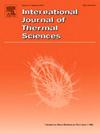利用分子动力学模拟揭示纳米碳化硅增强润滑油的导热性和黏性机理
IF 4.9
2区 工程技术
Q1 ENGINEERING, MECHANICAL
International Journal of Thermal Sciences
Pub Date : 2025-05-27
DOI:10.1016/j.ijthermalsci.2025.110020
引用次数: 0
摘要
提高汽车润滑油的传热能力和了解其流变特性对提高发动机性能和耐久性至关重要。本研究通过实验和分子动力学(MD)模拟研究了影响上述性能的重要参数,即聚α-烯烃(PAO6)和纳米碳化硅(SiC)纳米流体(NF)的导热系数和动态粘度。该方法的新颖之处在于探索了润滑油界面内形成的纳米sic涂层的影响,以及其对粘度的影响以及促进润滑剂层之间热传导增强的机制。实验和MD模拟结果表明,NF表现出剪切减薄的特性,SiC NF在20 ~ 60℃的动态粘度值呈指数级降低。此外,实验和模拟结果表明,受温度和纳米sic浓度的影响,NF的导热系数比基础油提高了4.7%和10.5%。基于分子水平结构和相互作用数据的原子径向分布函数(RDF)分布图表明,纳米sic的存在使微观结构从液相转变为纳米层状固态。这种改变增加了NF分子的有序性,促进了更有效的能量交换,从而提高了它们的导热性和粘度。最后,本研究有助于按照规定的操作要求设计NF。本文章由计算机程序翻译,如有差异,请以英文原文为准。
Revealing the thermal conductivity and viscosity mechanism of lubricating oil enhanced with nano-silicon carbide using molecular dynamics simulation
Enhancing the heat transfer capability and understanding the rheological properties of automotive lubricants are essential for improving engine performance and durability. This study investigated the important parameters influencing the above-mentioned performance, namely the thermal conductivity and dynamic viscosity of the nanofluid (NF) based on poly-α-olefin (PAO6) and nano-silicon carbide (SiC) via experiments and molecular dynamics (MD) simulations. The fascinating novelty of this approach lies in exploring the effects of the coating layer formed on nano-SiC within the lubricant interface, as well as its influence on viscosity and the mechanisms that facilitate enhanced heat conduction between lubricant layers. The experiment and MD simulation revealed that NF exhibited shear thinning behavior and the dynamic viscosity values of SiC NF from 20 °C to 60 °C were exponentially reduced. Moreover, the thermal conductivity of NF is improved by 4.7 % and 10.5 % than that of base oils for experiemnt and simulation outcomes, which were influenced by temperatures and nano-SiC concentrations. The distribution diagram of the atom radial distribution function (RDF), based on the structural and interactional data at the molecular level, indicates that the presence of nano-SiC transforms the microstructure from a liquid phase to a nanolaminar solid state. This alteration increases the orderliness of the NF molecules and facilitates more efficient energy exchange, thereby improving their thermal conductivity and viscosity. Finally, this study assists the design of NF in accordance with specified operating requirements.
求助全文
通过发布文献求助,成功后即可免费获取论文全文。
去求助
来源期刊

International Journal of Thermal Sciences
工程技术-工程:机械
CiteScore
8.10
自引率
11.10%
发文量
531
审稿时长
55 days
期刊介绍:
The International Journal of Thermal Sciences is a journal devoted to the publication of fundamental studies on the physics of transfer processes in general, with an emphasis on thermal aspects and also applied research on various processes, energy systems and the environment. Articles are published in English and French, and are subject to peer review.
The fundamental subjects considered within the scope of the journal are:
* Heat and relevant mass transfer at all scales (nano, micro and macro) and in all types of material (heterogeneous, composites, biological,...) and fluid flow
* Forced, natural or mixed convection in reactive or non-reactive media
* Single or multi–phase fluid flow with or without phase change
* Near–and far–field radiative heat transfer
* Combined modes of heat transfer in complex systems (for example, plasmas, biological, geological,...)
* Multiscale modelling
The applied research topics include:
* Heat exchangers, heat pipes, cooling processes
* Transport phenomena taking place in industrial processes (chemical, food and agricultural, metallurgical, space and aeronautical, automobile industries)
* Nano–and micro–technology for energy, space, biosystems and devices
* Heat transport analysis in advanced systems
* Impact of energy–related processes on environment, and emerging energy systems
The study of thermophysical properties of materials and fluids, thermal measurement techniques, inverse methods, and the developments of experimental methods are within the scope of the International Journal of Thermal Sciences which also covers the modelling, and numerical methods applied to thermal transfer.
 求助内容:
求助内容: 应助结果提醒方式:
应助结果提醒方式:


